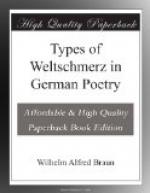In Lenau’s case we noted circumstances which point to a direct transmission from parent to child of a predisposition to melancholia. In Heine’s, on the other hand, the question of heredity has apparently only an indirect bearing upon his Weltschmerz. To what extent was his long and terrible disease of hereditary origin, and in what measure may we ascribe his Weltschmerz to the sufferings which that disease caused him? The first of these questions has been answered as conclusively as seems possible on the basis of all available data, by a doctor of medicine, S. Rahmer, in what is at this time the most recent and most authoritative study that has been published on the subject.[185] Stage by stage he follows the development of the disease, from its earliest indications in the poet’s incessant nervous headaches, which he ascribes to neurasthenic causes. He attempts to quote all the passages in Heine’s letters which throw light upon his physical condition, and points out that in the second stage of the disease the first symptoms of paralysis made their appearance as early as 1832, and not in 1837 as the biographers have stated. To this was added in 1837 an acute affection of the eyes, which continued to recur from this time on. In addition to the pathological process which led to a complete paralysis of almost the whole body, Rahmer notes other symptoms first mentioned in 1846, which he describes as “bulbaer” in their origin, such as difficulty in controlling the muscles of speech, difficulty in chewing and swallowing, the enfeebling of the muscles of the lips, disturbances in the functions of the glottis and larynx, together with abnormal secretion of saliva. He discredits altogether the diagnosis of Heine’s disease as consumption of the spinal marrow, to which Klein-Hattingen in his recent book on Hoelderlin, Lenau and Heine[186] still adheres, dismisses as scientifically untenable the popular idea that the poet’s physical dissolution was the result of his sensual excesses, finally diagnoses the case as “die spinale Form der progressiven Muskelatrophie"[187] and maintains that it was either directly inherited, or at least developed on the basis of an inherited disposition.[188] He finds further evidence in support of the latter theory in the fact that the first symptoms of the disease made their appearance in early youth, not many years after puberty, and concludes that, in spite of scant information as to Heine’s ancestors, we are safe in assuming a hereditary taint on the father’s side.
The poet himself evidently would have us believe as much, for in his Reisebilder he says: “Wie ein Wurm nagte das Elend in meinem Herzen und nagte,—ich habe dieses Elend mit mir zur Welt gebracht. Es lag schon mit mir in der Wiege, und wenn meine Mutter mich wiegte, so wiegte sie es mit, und wenn sie mich in den Schlaf sang, so schlief es mit mir ein, und es erwachte, sobald ich wieder die Augen aufschlug. Als ich groesser wurde, wuchs auch das Elend, und wurde endlich ganz gross und zersprengte mein.... Wir wollen von andern Dingen sprechen...."[189]




